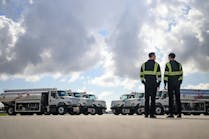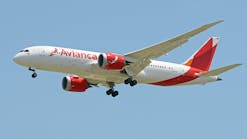Now Is the Time to Let Sustainable Aviation Fuel Take Off
The conversation on air travel during COVID-19 and in a post-pandemic world has centered around increased sanitization and the re-imagining of a cabin with sneeze guards and no middle seat. Rightfully so, health and safety is always first.
However, as the world continues to rethink the in-flight experience, we must also start an open dialogue to address environmental concerns.
U.S. aviation (commercial, general, freight, private, and military) accounts for 2.6 percent of total domestic greenhouse gas emissions, and 9 percent of total emissions from the U.S. transport sector.
Following the COVID-19 pandemic, the U.S. aviation industry is expected to grow: the Federal Aviation Administration (FAA) forecasts an increase in U.S. airline passengers from 917 million in 2019 to 1.31 billion by 2039—a 43 percent increase over a 20-year period. Over the same period, the FAA projects that jet fuel consumption will increase from 24.08 billion gallons to 30.64 billion gallons. While the trajectory of this growth will be delayed due to the pandemic, the future is still one with more planes in the sky.
Now is the time to create a post-pandemic recovery plan that puts sustainability at the heart of the aviation industry. With the eventual reawakening of air travel and the associated increase in emissions, the necessity for sustainable aviation fuel (SAF) is clear.
Globally, more than 40 airlines now have already implemented SAF at some level, with an estimated 200,000 commercial flights using SAF since 2011 and 1.6 billion gallons of SAF committed to forward purchase agreements.
Put another way, sustainable aviation fuel is already here. It’s powering aircraft with much less greenhouse gas emissions - up to 80 percent less carbon dioxide equivalent on a lifecycle basis compared to conventional jet fuel. SAF also emits less pollution, which contributes to cleaner air in communities located near airports.
The switch to SAF is eased by the fact that it’s an energy dense liquid fuel and chemically speaking, similar to conventional jet fuel. The big difference - SAF is made from 100% renewable raw materials. The chemical similarities mean that SAF is a drop-in solution with existing aircraft engines and airport infrastructure. Seeing the potential, companies like Neste, World Energy, LanzaTech and others are leading the way in producing this drop-in fuel.
For example, Neste began commercial sales of sustainable aviation fuel in the U.S. in early 2020. Moving quickly, the company has already delivered its first batch of sustainable aviation fuel to California. A process that created benefits for many U.S. businesses who helped produce, transport and store the fuel.
Airlines, airports and fuel producers are working together to create a market for SAF, policy priorities need to walk hand-in-hand for a greener future for aviation.
Currently, SAF is largely included as a supplement to existing emissions policies that focus on ground transportation, but SAF merits its own specific policies.
The reality is that air travel is different from road travel, in terms of forecasted growth and the lack of available alternative fuel types. Replacing conventional jet fuel with SAF will be critical for our society to create a future where air travel does not have to be limited.
During a recent conversation with the Atlantic Council where the report Sustainable Aviation Fuel Policy in the United States: A Pragmatic Way Forward was unveiled, five key policy action areas were highlighted that could invigorate SAF production and use. These included: Attract capital to expand SAF supply; assist SAF facility operation; recognize SAF environmental benefits through carbon pricing and other systems; create structural SAF demand; and demonstrate government leadership.
For these actions to work, policy efforts must first seek to reduce barriers to produce SAF and push for increased SAF production through a new program or tax design.
Additionally, addressing the price gap is essential. Fuel is the biggest cost for the aviation industry. So, it’s not surprising that airlines are cautious when it comes to using SAF given its higher cost vs. conventional jet fuel. Creating a market based, technology-neutral policy framework that puts a true price on carbon could help resolve this pinch point, spurring both the production and use of SAF.
The ebb in air travel due to COVID-19 is the perfect moment to address emissions and begin the dialogue around pragmatic federal policies that could encourage the widespread use of SAF across the nation.
The airline industry is ready. Renewable Fuel producers are ready. And with the right federal policy support, sustainable aviation fuel will be able to take off.
Chris Cooper is Vice President for Renewable Aviation at Neste North America, a Finland-based multinational renewable fuel, and renewable polymer and chemicals company. In 2020, the Corporate Knights Global 100 ranked Neste as the third most sustainable company in the world.







